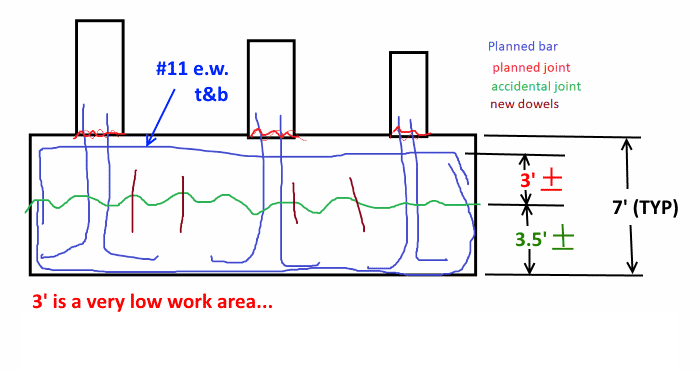canwesteng said:
In any case the plan is to go do it in one go...they haven't done a job this big.
I'm thinking the best case is get good consolidation of the concrete, get it roughly level, make sure we get some wet burlap on it, then come back the next day, roughen, insert dowels, wet the surface and continue pouring.
Oh, Brother...
Appears there is no plan, just hope for the best.
The Owner should hire and empower a qualified, independent Construction Manager experienced in mass concrete placement. First thing the CM should do is require the Contractor to submit a detailed plan for review by the EOR and CM.
ACI has the so called
90 minute rule for concrete placement. Concrete, even with retarder or fly ash, does not go into suspended animation because it is kept wet. No one is going to be able to insert dowels into structural concrete that is 18+ hours old... and this raises plenty of other questions:
1) Focusing on how to perform a bonded overlay is a concern, but there are much bigger problems:
The cold joint, where the bonded overlay work would take place is inaccessible INSIDE the #11 rebar cage with limited overhead clearance (see the marked up sketch below).
2) The rebar top mat cannot just just be "disassembled", lap splices at the perimeter are embedded in concrete. Will have to cut the mat out with acetylene torches. Then the cold joint can be prepared for the overlay. However,the overlay cannot take place until a replacement top mat has been installed. Installing the the replacement top mat will NOT be a "piece of cake" either. Lap splices at the perimeter are likely not an option because to limited length available above the space above the lower portion of the mat. Each #11 will need a mechanical or Cadweld splice.
3) Has anyone checked to see if the concrete forms are structurally sufficient for a 7' deep placement... responsibility of Contractor as part of his "means and methods".
4) Will a mud mat be used be ensure that work does not take place in real "mud"?
5) Depending on #11 rebar spacing, the top mat will may weigh many thousands of pounds. An internal structural system will be needed to properly support the top mat and keep it in place during concrete placement. Another of the Contractor's means and methods responsibilities.
6) Why should a contingency plan focus on ONLY the best case (about mid-depth) for an unplanned horizontal cold joint? The cold joint is just as likely to occur with either 6 inch or 6 feet of concrete in the forms which paint an entirely different (and daunting) picture about a solution.
7) I'm not going to go into all details, but logistical considerations need to be addressed by the Contractor... in advance. Things like expected concrete delivery rate (yd
3 per hour to jobsite), plan for where concrete is placed (the entire horizontal cross section of the mat needs to the raised at a uniform rate to ensure that the entire concrete working surface remains fresh), schedule for the day of the placement including how to control mass concrete temperature, backup equipment on site, etc.
Also, a qualified CM should review the EOR's plans and specs for constructability. What is rebar spacing of the #11 rebar mats? Tell us, and FWIW I'll give you and opinion and a reason why the spacing is either "good" or "bad" from a construction point of view.
![[idea] [idea] [idea]](/data/assets/smilies/idea.gif)

![[idea] [idea] [idea]](/data/assets/smilies/idea.gif)
